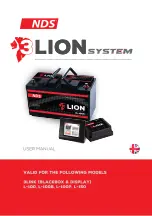
To order parts and supplies: 800.345.1178 >> eastwood.com
7
ENGINE STARTING
Important Notes:
• The engine start function can supply up to 50 Amps of current during engine starting. This function
is protected by an Automatic-Reset Overload Breaker, and there is a 5-second cranking limit at
this output level.
• Do not make battery and chassis connections with the Battery Charger connected to AC power.
1. Move the charge rate switch to “50 AMP ENGINE START.”
2. Attach charger clamps to battery connections, per following procedure, ensuring a good connection.
Note:
If polarity is reversed, the “Reverse Polarity” indicator LED will illuminate red when
the Battery Charger is plugged in.
3. Check and confi rm polarity of battery terminals:
Positive = ( +, POS, P)
Negative = ( –, NEG, N)
4. Determine which terminal of battery is grounded (connected) to the chassis. If negative terminal
is grounded to chassis (as in most vehicles), it is a negative ground system. If positive terminal is
grounded to the chassis, it is a positive ground system.
5.
For negative-grounded vehicle,
connect positive (RED) charger clamp from Battery Charger to
positive ( +, POS, P) ungrounded terminal of battery. Connect negative (BLACK) charger clamp to
vehicle chassis or engine block away from battery. Do not connect charger clamp to carburetor, fuel
lines or sheet metal body parts. Connect only to heavy gauge metal part of the frame or engine block.
6.
For positive-grounded vehicle,
connect negative (BLACK) charger clamp from Battery Charger to
negative ( –, NEG, N) ungrounded terminal of battery. Connect positive (RED) charger clamp to
vehicle chassis or engine block away from battery. Do not connect charger clamp to carburetor,
fuel lines or sheet metal body parts.
7. Connect only to a heavy gauge metal part of the frame or engine block. Plug Battery Charger power
cord into a 110/120-volt, 60Hz AC power outlet. The red “Power On” LED will illuminate.
Note:
If polarity is reversed, the “Reverse Polarity” indicator LED will illuminate Red when
the Battery Charger is plugged in. Disconnect the Battery Charger and check your connections.
8. Begin cranking the engine in 3-second intervals until the engine starts with a rest time of 4 minutes
between each cranking interval to allow the starter to cool. Cranking longer will trip the
Automatic-Reset Overload Breaker. Do not crank the engine for more than 3 seconds at a time.
If the engine fails to start, you may change the position of the charge rate switch and charge
the battery without disconnecting the Battery Charger from AC power.
9. Once the engine starts, disconnect the Battery Charger plug from the 110/120-volt AC power outlet.
10. Disconnect the cables and clamps in the reverse order in which they were connected.
Disconnect the fi rst cable as far away from the battery as possible.


























